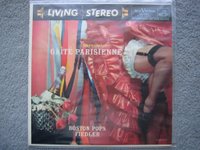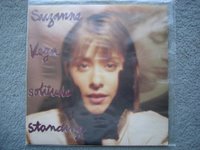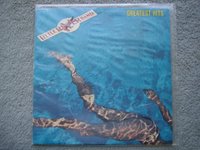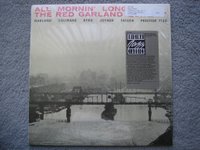[audioasylum thread - read it here]
I have a Thorens TD160B Mk II turntable and have meticulously setup the turntable, adjust the springs and spent many times fiddling with VTAs and Platter spring tensions. After all of these tweaking I felt there is nothing more I can try until I read all the raves about Ringmat platter mats. I always thought they are way too overpriced so I decided to make one myself. I thought that would be more exciting since I can try several variations. Upon reading some DIY mat projects at The Analog Department I went to purchase a drawing paper and some multi-purpose cork roll (24” x 48”) for around CAD 10 and CAD15, respectively. After making some different sample trials and loads of fun, I settled for this sample.
Pictured below (clockwise from top): DIY Ringmat top side, DIY Ringmat platter side, Original Thorens mat and Drawing paper used in the project.



I built this a year ago and it replaced my original Thorens mat. Lately, I decided to share this to any DIYer out there who might want to give it a try and see if they have the same improvement results. Below is a short comparison of the sound of this DIY Ringmat to the original Thorens mat:
Offenbach - Caite Parisienne (RCA Living Stereo Red Seal LSC-1817) The Thorens mat is more livelier, a tad forward and little faster than the DIY platter. The DIY mat in comparison is a little laid back, more quiet, with speed that is a little slower compared to the Thorens mat. The bass, however, is a little more defined. I have exchanged the 2 mats several times and it was hard to favor one from the other. There were some differences but the difference wasn’t that big. I would say that for an untrained ears they will not discern the difference. I was a little worried. It has been a year now since I have been using this DIY permanently and during that time I knew it simply blew away the Thorens mat and all the other DIY mats I tried. Perhaps I was more biased during that time since I was so proud of making them myself. Anyways, I favor the Thorens mat a little bit because of the extended highs.
The Thorens mat is more livelier, a tad forward and little faster than the DIY platter. The DIY mat in comparison is a little laid back, more quiet, with speed that is a little slower compared to the Thorens mat. The bass, however, is a little more defined. I have exchanged the 2 mats several times and it was hard to favor one from the other. There were some differences but the difference wasn’t that big. I would say that for an untrained ears they will not discern the difference. I was a little worried. It has been a year now since I have been using this DIY permanently and during that time I knew it simply blew away the Thorens mat and all the other DIY mats I tried. Perhaps I was more biased during that time since I was so proud of making them myself. Anyways, I favor the Thorens mat a little bit because of the extended highs.
Suzanne Vega – Solitude Standing, track Tom’s Diner (A&M RML 53233 SP-5136) The Thorens mat has that irritating “Ssssss” sound and is a little thick and hard in the upper bass. The DIY? none of that “Ssssss”, hardness and thickness in the upper bass. The DIY is also more quieter. The recording space is more realistically presented. Could it be that in the Offenbach comparison that livelier sound of the Thorens mat was inaccurate high? Winner – DIY mat.
The Thorens mat has that irritating “Ssssss” sound and is a little thick and hard in the upper bass. The DIY? none of that “Ssssss”, hardness and thickness in the upper bass. The DIY is also more quieter. The recording space is more realistically presented. Could it be that in the Offenbach comparison that livelier sound of the Thorens mat was inaccurate high? Winner – DIY mat.
Little River Band – Greatest Hits, track Reminiscing (EMI ST-12247) I played the record using the DIY mat first and it was great, then I played it again with the Thorens mat and didn’t like the sound. I did not even finish the track and switched back to the DIY mat again just to make sure I am not biased – yes, I like the DIY better. The drums sound is more accurate and it wasn’t overpowered by the electric bass guitar. It’s more enjoyable. It’s more balanced and just right. The Thorens mat has a much more unruly bass that seems to resonate back and forth my listening room. It’s not good. Winner – DIY – by a wide margin.
I played the record using the DIY mat first and it was great, then I played it again with the Thorens mat and didn’t like the sound. I did not even finish the track and switched back to the DIY mat again just to make sure I am not biased – yes, I like the DIY better. The drums sound is more accurate and it wasn’t overpowered by the electric bass guitar. It’s more enjoyable. It’s more balanced and just right. The Thorens mat has a much more unruly bass that seems to resonate back and forth my listening room. It’s not good. Winner – DIY – by a wide margin.
All Mornin’ Long – The Red Garland Quintet (Original Jazz Calssic OJC-293) Playing “They can’t take that away from me”, the Thorens mat’s highs break up easily. There is a feeling of more live sound but the treble is not that airy. The trumpet may be good to a non-audiophile but “no-thanks” for me. I will not say anything more, after 2 minutes I put the DIY mat back and played it again from the start – ahh – the trumpet – you can hear the air coming out of the horn and I am not imagining it. The cymbal is very good and the transient attack of the drums is just right. Imaging is superb. Winner – DIY?
Playing “They can’t take that away from me”, the Thorens mat’s highs break up easily. There is a feeling of more live sound but the treble is not that airy. The trumpet may be good to a non-audiophile but “no-thanks” for me. I will not say anything more, after 2 minutes I put the DIY mat back and played it again from the start – ahh – the trumpet – you can hear the air coming out of the horn and I am not imagining it. The cymbal is very good and the transient attack of the drums is just right. Imaging is superb. Winner – DIY?
To summarize:
I haven’t heard any Ringmat product but this DIY version that I made was far better than the original Thorens mat. I have also compared the DIY to some DIY platter mats found in The Analog Department but this DIY version that I made has the more positive effect (at least in my system). I have also made several versions of this DIY using the same cork and drawing paper but this configuration has by far produced the best results. Please remember that I have only tried this using my Thorens table. I am not sure how it will sound in a solid platter non-spring suspension table. If you do, please share your experience as well.
For those of you who are willing to try it I encourage you to try different versions – size and locations of the rings on both sides of the patter. In my experience, a small difference in the spacing of the rings produced different tones – probably because of different tightness of the suspension. The nice thing about it is you can tweak it and adjust the tone according to your preference or what you need.
One of the advantages of an audiophile living in North America is the abundance of audio components in the used market. Audiogon is the most popular of these high end audio portals. Back when I still live in Asia it’s a challenge to find a gem in that relatively small used audio marketplace. If you do, chances are it's not in a mint condition (mechanically, electronically and aesthetically) and if it is, they are way overpriced compared to blue book value.
Not the case here in Canada and US, the price performance value ratio of used audio equipments here is a bonus. They are also priced favorably (read “reasonably”) and is affordable by the average salaried Joe who’s serious about owning a decent sounding audio rig. Having said that, it is easy to assemble an el-cheapo no-nonsense starter analog front end for the price of what you will have to pay for a new personal computer. I know I have friends there who want to try the analog domain but are put off by the high entry price. Why not start with used and vintage gears. Here are some recommendations (if you live in the Greater Toronto Area).
Turntable – Thorens TD160 Mk II (CAD 325 with arm)
Cartridge – Grado Prestige Black (less than CAD 50 low hours)
Integrated Amplifier w/ phono – Used Luxman (made in Japan) CAD 250, or, Marantz 2285 Receiver (can be purchased around CAD 250 in flea market stores)
Speakers – Proac Studio bookshelf, JBL L40, Signet SL16, , Spendor (from CAD 300 to 500)
Cables – Buy used from audio dealers (CAD 100). Or, try making the Home Depot 14 gauge speaker cable. I tried it and it’s not bad. Of course it cannot compete to high end cables but better than ordinary cables marked as speaker wires that you can buy from Best Buy. (Hmmm, maybe I can write about this fun experiment experience in my future post)
Caveat:
[1] Sorry, no tubes at this price point and so don’t expect a tube sound but it will still be much better compared to many entry level solid-state based systems out there. However, you can easily sell your CAD 250 integrated when you are ready for the tube sound upgrade. But at least you can now start enjoying your vinyls.
Fun Factor:
[1] Of course you can always hook up your portable CD player or iPod in one of the many line level inputs
[2] Hook up your DVD player for that home theater like movie sound
[3] Tweaking your turntable for optimum performance
[4] And the biggest fun of all is hunting that favorite vinyl. Well, at least for me that is where most of the fun is. whether that is the $3 used vinyl or the $30 jazz classic reissue in 180g it is hard to fault the sound from vinyl.
Well, there you have it! Good Luck, and email me the result of your quest.
[audioasylum thread - read it here]
Most audiophiles have marked in their calendar a “REASONable” date for the next purchase - a date that is commonly associated with an occasion to celebrate. Since I told myself many times that I will hold all audio equipment purchase until we moved to our new home; last Saturday, I was digging unsorted records in the flea market and I was lucky to find two Sinatra sealed records for Canadian $3 each . I guess this will be my Fathers Day’s gift for myself.
I must have 5 or 6 Sinatra albums already but the album on the top is the best of them all in terms of recording quality. The material is also excellent! The record on the bottom has excellent material but the recording quality is average.
The Best of Frank Sinatra (Capitol SN-516109)
Young at Heart
Hey! Jealous lover
All the way
Withcraft
Chicago
Come dance with me
Only the lonely
High hopes
Nice 'N Easy
Put your dreams away
Frank Sintra Sings for Only The lonely (Capitol SM-501053)
Only for the lonely
Angel Eyes
What's new
Willow weep for me
Good-bye
Blues in the night
Guess i'll hang my tears out to dry
Ebb tide
Gone with the wind
One for my baby
Critical Listening – Learn the audiophile lingo, part 1
0 Comments Published by William on June 13, 2006 at 7:57 PM.This hobby is all about building a system, where, when you retire at the end of the day, you can fire up your system and ask yourself, who will be performing in my listening room tonight? The experience should allow you (when you dim the lights) to be transported vicariously to a “you are there” in the concert hall venue or, “they are here” in your listening room experience.
However, before you even get close to getting there, you must first build a system that is capable of taking you there – easier said than done. System building is an art. Before you start your shopping list you’ll be better off knowing the audiophile lingo so that you will be in the same page with the audio salesman when he start describing the tonal quality of the equipments you are about to audition.
Allow me to explain some of these audiophile terms (in parts since this can be a long post if I don’t break it up to several parts).
Soundstage – The ability of the system to reproduce the actual recording space from a live performance or recording venue setup is one of the most important tasks a system should be able to deliver. To put it simply, your system should reproduce the drama of a large-scale Tchaikovsky's 1812 overture, (ok, maybe this is too much but just to make a point) and the intimate small-scale work of a chamber orchestra. Your system should replicate a believable reproduction of music (sound) no matter what the scale (stage) is.
Imaging – You should be able to pinpoint in the soundstage where the individual instruments and performers are located in a 3D soundstage. This attribute pertains more to the width location of the sound.
Depth – If imaging refers more to “how wide is the stage” is and how you can easily discern the location of a particular sound left to right, depth, on the other hand refers to the layering of the sound from the front all the way back of the soundstage. If the soundstage is too forward, the listener will have the impression that he is sitting within the first three rows of seat in the theater. If the soundstage is too backward, the listener will have the impression that he is seated in the bleachers.
Presence – the ability of the system to reproduce a holographic believable realism where you experience goose bumps and are fooled to believe that the performers are in the same room as you are. Sam Tellig, one of the regular contributors in Stereophile always used the term “palpable presence” in his writing. I don’t know if he is the one who coined the term but I think he nailed it. This sound attribute is one of the reasons audiophiles remain loyal to the hobby.
(to be continued … )
It’s Sayonara not Auf Wiedersehen for the 3 Tenors
0 Comments Published by William on June 11, 2006 at 9:44 PM.Part of the excitement for me of the coming of the next World Cup is to watch the 3 Tenors (Luciano Pavarotti, Placido Domingo and Jose Careras) serenade the world again with the best-loved Arias in the Finals. Sadly, that will not happen this time. It seemed true that Yokohama Arena was indeed their last trio World Cup performance.
I would have been thrilled if the Italian cross-over tenor Andrea Bocelli replaces Luciano Pavarotti (who retired on his 70th birthday) to continue the tradition.